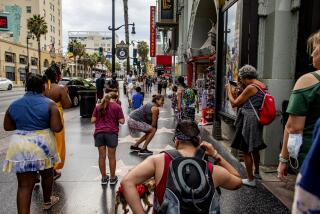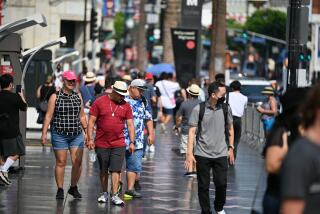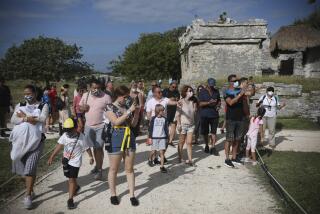Mexico Moves to Lure Quake-Wary Tourists
Mexican tourism officials, trying to counter the images of smoldering rubble, death and destruction that accompanied the Sept. 19 earthquake, made their pitch Friday in San Diego as part of a large-scale campaign to encourage vacationers to travel south of the border.
In 1985, Mexican authorities said, the earthquake and previous reports of internal violence have contributed to a 10% drop in tourist revenues for the already-beleaguered Mexican treasury.
“We welcome American tourists,” said Mario Salomon Pineda, international marketing director for Mexico’s Tourism Ministry, speaking at a press conference at the Sheraton Harbor Island West. “Mexico is a very safe place to travel for Americans. . . . The earthquake’s damage was very limited.”
The news conference and a series of meetings with travel industry representatives were part of a slick, $10-million effort--a worldwide campaign described as the largest such initiative ever launched by the Mexican government.
Government officials are trying to offset reports of an earthquake-battered nation--a travel agent’s nightmare--with positive images of American tourists sipping tropical drinks along balmy seashores.
The scope of the campaign demonstrates just how eager Mexican officials are to avert further losses in a tourism industry that provides the national treasury with roughly $2 billion a year--making it the second most important source of foreign currency after oil exports, according to government officials.
Largely because of the earthquake, officials said, Mexico is expected to lose $200 million this year in tourist revenues. Meanwhile, the nation faces a continuing economic crisis and a foreign debt of more than $90 billion.
Salomon repeatedly attempted to underplay the damage done by the earthquake, which left as many as 8,000 dead. In Mexico City, the area hit hardest, Salomon noted that fewer than 5% of the capital’s 35,350 hotel rooms were damaged. Tourists are now able to travel freely throughout the nation, he said, adding that damaged buildings are being repaired, telephone service is being restored and there is no danger of a post-earthquake epidemic. Salomon stressed the fact that most tourist destinations were undamaged by the quake.
Mexican tourism officials played a five-minute color videotape, prepared by a U.S. advertising firm, showing smiling American tourists basking in luxury at various sun-splashed vacations spots in Mexico. The tape was made after the earthquake, officials said.
“Mexico will be a very good value for American tourists,” Salomon added, noting that the peso has plummeted to an all-time low of almost 500 to the dollar. In the next breath, he voiced the hope of many Mexican officials: that the peso will somehow recover and gain value against the dollar.
Nonetheless, the plummeting peso does seem to have prompted additional visits to Tijuana by Americans in search of bargains, according to the Tijuana Chamber of Commerce. And several San Diego travel agencies contacted Friday said the devaluation has spurred interest in vacationing in Mexico, although there is still some hesitancy because of the earthquake.
“People are calling all the time, trying to get a bargain,” said Yvonne Gomez, an agent at All The World Travel in San Diego. “People will forget about the earthquake real quick if prices are right.”
More to Read
Sign up for Essential California
The most important California stories and recommendations in your inbox every morning.
You may occasionally receive promotional content from the Los Angeles Times.










